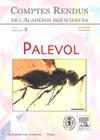Bird remains from the Middle Paleolithic levels (MIS3) of Llonin Cave (Peñamellera Alta, Asturias, Spain)
IF 1.3
4区 地球科学
Q3 PALEONTOLOGY
引用次数: 0
Abstract
Birds are abundant in fossil assemblages of Quaternary sites; they can be used in landscape reconstruction as they are well adapted to the environment. Here we present the analysis of the avian assemblage from the Middle Paleolithic levels of the Llonin Cave, where 558 bird remains have been recovered from levels G-VI and CP-VIII, belonging to at least ten different taxa: Aves indet., Galliformes indet., Lagopus lagopus Linnaeus, 1758, Tetrastes bonasia Linnaeus, 1758, Columba livia/oenas Gmelin, 1789/Linnaeus, 1758, Passeriformes indet., Alaudidae indet., Motacilla sp., Turdus sp., Corvidae indet., Garrulus glandarius Linnaeus, 1758, Pyrrhocorax sp., Pyrrhocorax pyrrhocorax Linnaeus, 1758, Pyrrhocorax graculus Linnaeus, 1766 and Corvus corax Linnaeus, 1758. This assemblage is similar to other assemblages from the Upper Pleistocene of the north of the Iberian Peninsula, and it reflects a mixed landscape, with open areas and woodland. The taphonomic analysis points to a mixed origin of the accumulation, mainly formed by medium-sized corvids dying in the cave, and also raptors accumulating their prey.Llonin洞穴(Peñamellera Alta,阿斯图里亚斯,西班牙)旧石器时代中期(MIS3)的鸟类遗骸
第四纪遗址化石组合中鸟类丰富;它们具有良好的环境适应性,可用于景观重建。本文对Llonin洞穴旧石器时代中期水平的鸟类进行了分析,其中在G-VI和CP-VIII水平发现了558具鸟类遗骸,属于至少10个不同的类群:鸟类indet。;;;;Linnaeus, Lagopus Lagopus Linnaeus, 1758, tetrastastus bonasia Linnaeus, 1758, Columba livia/oenas Gmelin, 1789/Linnaeus, 1758, passerformes indeeus。, Alaudidae indet。, Motacilla sp., Turdus sp., Corvidae indet。山嘴鸦,1758年;山嘴鸦,1758年;山嘴鸦,1766年;山嘴鸦,1758年。该组合与伊比利亚半岛北部上更新世的其他组合相似,反映了一个混合景观,有开阔地区和林地。埋藏学分析指出,这种堆积的来源是混合的,主要是由在洞穴中死亡的中型鸦类形成的,也有猛禽聚集猎物的原因。
本文章由计算机程序翻译,如有差异,请以英文原文为准。
求助全文
约1分钟内获得全文
求助全文
来源期刊

Comptes Rendus Palevol
地学-古生物学
CiteScore
2.10
自引率
0.00%
发文量
39
审稿时长
17.6 weeks
期刊介绍:
Comptes Rendus Palevol is a fully electronic and peer-reviewed journal, with a continuous publication stream, devoted to palaeontology, prehistory and evolutionary sciences. It publishes original research results, in French or English, in the following domains: systematic and human palaeontology, prehistory, evolutionary biology and macroevolution, and history of sciences. Thematic issues may also be published under the responsibility of a guest editor. All articles published in Comptes Rendus Palevol are compliant with the different nomenclatural codes. A copyright assignment will be signed by the authors before publication.
 求助内容:
求助内容: 应助结果提醒方式:
应助结果提醒方式:


